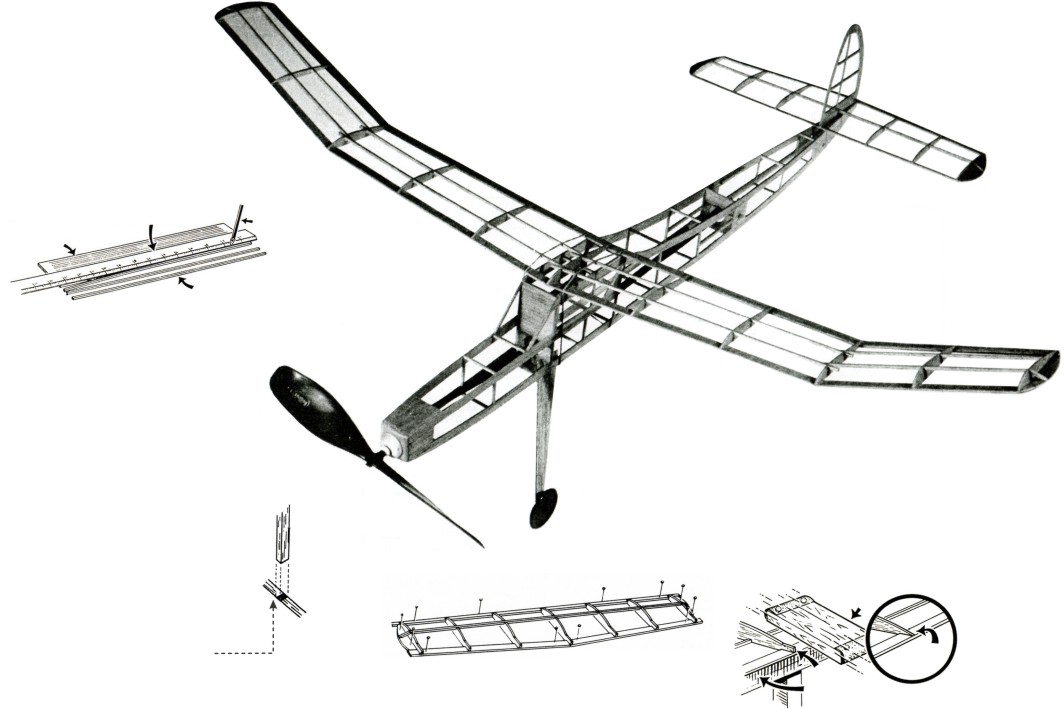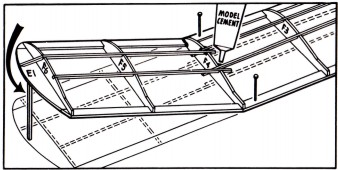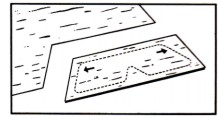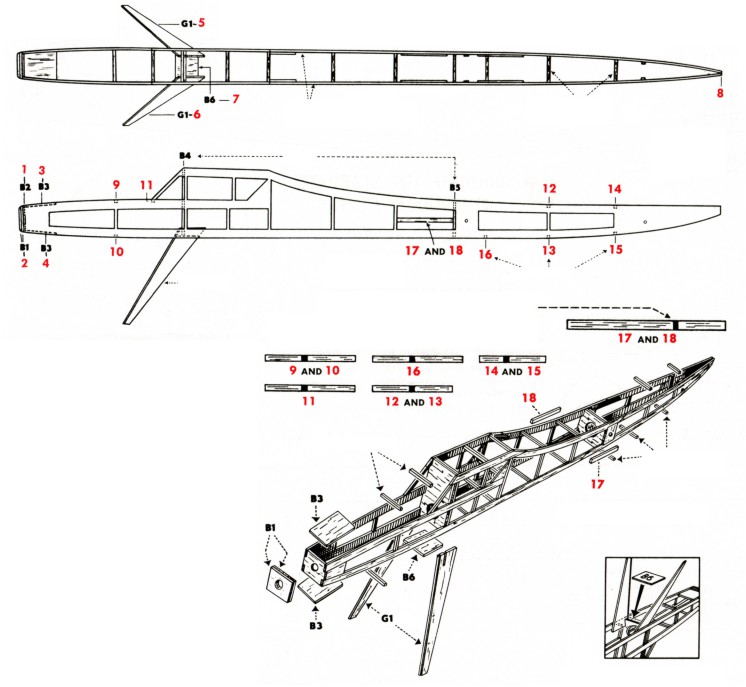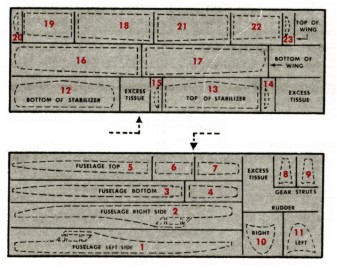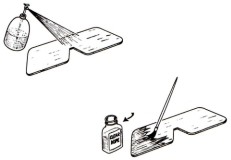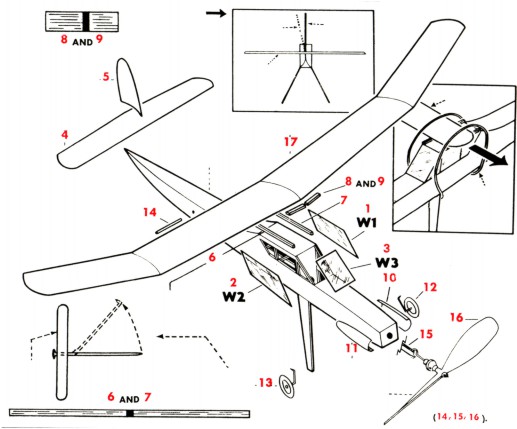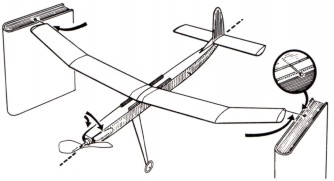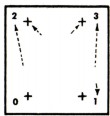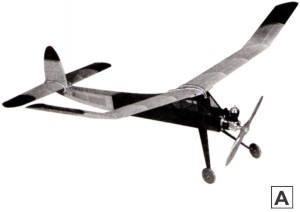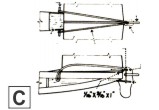REMEMBER! THESE SOLID BLACK AREAS INDICATE THE WIDTH AND THICKNESS BALSA STRIPS.
KIT 604
LANCER
24" WING SPAN
A "Junior Contest" Semi-scale Model
GUARANTEED TO FLY IF INSTRUCTIONS ARE FOLLOWED
COPYRIGHT 1966 BY PAUL K. GUILLOW, INC.
The frames for model are assembled directly over the full size layouts printed on this side of plan. The plan has been divided into easy-to-read work areas and it is suggested that, starting with area "A," you complete the frames in one area before starting the next frame project.
Although the frames are built directly on the layouts the plan MUST first be laid flat on a workboard and covered with wax paper to prevent frames from sticking to it during assembly. For a workboard, use corrugated cardboard, soft wood, Celotex, etc.—any flat surface into which you can easily stick common pins.
The model frames are built from balsa sheet and strip stock. Parts on the sheet stock are die-cut and lettered to correspond with the letters on the plan (CI, C2, C3, etc.). The strips, which are cut to various short lengths as needed, must first be cut to FULL LENGTH from the sheet of strips as illustrated below.
IMPORTANT PRE-WORK INFORMATION
In addition to the contents of this kit, you will need the following tools and accessories: model airplane cement, clear dope, dope thinner, ¼" wide artist brush, model knife and fine sandpaper all of which can be obtained at your local hobby store. Also required and usually found at home are common pins (50), wax paper and a single edge razor blade.
TOOLS AND ACCESSORIES REQUIRED
DETAIL OF AIRPLANE FRAME WORK
NOTE: ALL FRAMES COVERED WITH TISSUE BEFORE ASSEMBLY!
Plan and Instruction Sheet
PATENT APPLIED FOR
SPECIAL NOTE!
DO NOT use plastic model cement for building this model.
BUILDING THE STABILIZER AND RUDDER FRAMES
The balsa frame pieces are cemented to each other as they are placed on the layouts
Use common pins to fasten pieces in place-locations shown by black dots.
Black letters indicate die-cut parts (all other pieces are cut from balsa strips).
Red numbers indicate order of frame assembly.
The width and thickness of balsa strips found by matching the end with the solid black areas on layouts (see sketch). Cut strips to length as needed.
Be sure to let cement dry HARD before removing frames from layouts then trim ends of balsa strips as indicated on plan.
Work carefully, sandpaper STABILIZER rib ends as shown in sketch.
Finally apply second coat of cement to all joints for added strength.
|
instead of bing flat frame like the stabilizer, the wing of this model is built with its four panels at different angles to each other as shown in the reduced size plan at right. (Drawing No. 1)
The building of this "angled" frame (known as polyhedral wing) is quite simple providing you follow the exact assembly sequence shown be the red numbers.
First build the entire wing frame flat on the Wing Layout following red numbers 1 thru 31 and, VERY IMPORTANT, making sure that NONE of the parts are cemented together where the wing panels join - see notes on Wing Layout. These parts MUST remain uncemented so they can move freely when doing steps 32, 33 and 34.
After completing step 31, remove all pins from the Right and Left Wing Tip Panels and raise them as shown in Drawing No. 2 using balsa strip under each wing tip to set correct height. Now
|
|
cement the parts together where these panels join the center panels (32 and 33).
When cement has hardened, remove pins from the Right Center Panel and raise it as shown in Drawing No. 3 again using a balsa strip for setting height. Cement all parts together where the Right and Left Center Panels join (34). This completes assembly of your "Polyhedral" wing frame. Remove remaining pins and lift wing frame from layout.
Trim ends of balsa strips as indicated on Wing Layout.
Work carefully, sandpaper wing rib ends as shown in Drawing No. 4 at right.
Finally, apply a second coat of cement to all joins for added strength.
|
BUILDING THE FUSELAGE (BODY) FRAME - STEP 1
Following the small red numbers, assemble the two side frames on the layouts just as you assembled the rudder and stabilizer frames. (Drawing No. 5)
When cement has dried, remove common pins CAREFULLY and then lift the LEFT SIDE frame from its layout.
The RIGHT SIDE frame remains on the layout with all pins removed except two or three thru die-cut parts A1-A2-A5 A6 as you can see in Drawing No. 6
|
The next step is to join the two frames together using die-cut formers B4 and B5 and eleven cross members that are cut from strip stock.
First cement formers B4 and B5 to the RIGHT SIDE frame where indicated on the layout. (DRAWING NO. 6). Next cement the LEFT SIDE frame to formers B4 and B5 and make SURE before cement dries that both the right and left side frames are in alignment, one exactly over the other. If not in perfect alignment, line up carefully by eye moving the left side frame back and forward as needed. When in correct position, brace with a book or similar object until cement dries.
Now cut needed cross members and cement
|
|
them carefully between the side frames where indicated by the red arrow heads. These too should be lined up carefully by eye. Suggestion: Try a pair of tweezers for installing cross members if you find it difficult to set them between the frames by hand. (Drawing No. 7)
While the fuselage frame is drying, select the two B1 formers and cement them together. (Drawing No. 8) Note how the "grain" of each former runs opposite direction. This is to strengthen the combined formers and prevent accidental splitting.
Select the die-cut LANDING GEAR STRUTS G1 and cement a piece of wire to the front edge of each for re-enforcement. (DRAWING NO. 9)
|
BUILDING THE FUSELAGE (BODY) FRAME - STEP 2
Instead of working on a layout, this second step in assembly is performed while you hold the frame in your hands or while it is setting on the workboard. The location of parts to be added to the fuselage frame are shown on the top and side views and Drawing No. 11 below. As before, follow the red numbers for proper work order.
First cement former B2 between nose end of side frames, holding together with your fingers or an elastic band until dry (1).
Next cement the double former B1 to former B2 (2).
Select parts B7 and cement in place between the side frames and against former B2 (3, 4).
Lay fuselage frame on its top and cement former B5 between side frames — pin in place until dry. (5)
Cement the landing gear struts G1 to former B4 and against the side frames where they touch (5,6). Immediately, while the cement is still wet, cement part B4 to landing gears, former B5 and between the side frames (7). See Drawing No. 10.
Now cement the tail ends of the side frames together (8). Hold with fingers or pin together until cement dries.
Next cut the remaining cross members from balsa strip stock and cement them in place between the side frames (9,10, 11, 12, 13, 14, 15, 16). The actual size of cross members shown near the No 11 Drawing.
Finally, cut and cement in place to two balsa strips that fit between former B5 and the next forward uprights (18,18). See Drawing No. 11.
SPECIAL NOTE:
The drawings that follow, except Drawing No. 21, are NOT pictures of the model you are building. They only show general way model parts are covered, doped, assembled, etc.
SANDING AND DOPING THE FRAMES
|
CLEAR DOPE: A special liquid used by model builders for priming balsa wood and as an adhesive for attaching tissue covering to model frames. Also used as
|
|
a protective coating over tissue covered frames when diluted in half with dope thinner. Clear Dope and Dope Thinner available at your hobby dealer.
|
Lightly sandpaper all frames to remove any balsa "fuzz" or cement "bumps." Give outside edges of all frames on coat of clear dope. (Drawing No. 12). When dry, give frames a final light "smooth-up" sanding.
COVERING THE FRAMES WITH TISSUE
Covering model frames with tissue is actually quite easy although often a problem for a beginner. The directions that follow show the five basic steps for covering a model frame and even a "first timer" can enjoy success if these instructions are carefully observed.
1. MARK AND CUT TISSUE OVERSIZE
2. BRUSH CLEAR DOPE ON OUTSIDE EDGES OF FRAME.
NO DOPE APPLIED ON INSIDE PIECES
5. DOPE EDGES - SMOOTH DOWN
FOR OVERLAP EDGES, CUT
TISSUE SO NO TRIM IS NEEDED
The five basic steps in covering are as follows:
1. Trace and cut tissue to size. (Drawing No. 13).
2. Apply coat of Clear Dope to frame. (Drawing No. 14).
3. Immediately set tissue on doped frame BEFORE it has a chance to dry and smooth flat with finger tips. (Drawing No. 15).
4. Trim off overhang with razor blade. (Drawing No. 16). Sandpaper can be used if blade no available.
5. Apply coat of Clear Dope to trimmed edges and smooth down any loose tissue with finger tips. (Drawing No. 17). Where a piece of tissue of tissue
overlaps another it is best to cut the overlapping edge so that no trim is needed. (Drawing No. 18).
The Tissue Pattern Key shows how tissue should be marked with soft pencil (solid lines) to get enough pieces to cover all parts. No need to trace actual frame outlines (dotted lines). Cut the square sections apart and dope to frames as needed following red numbers for best work order. Trim off "overhang" when dry.
Refer to Drawings No. 24 and 25 for motor installation. (14, 15, 16).
WATER SPRAYING AND DOPING COVERED PARTS
Before assembling model, spray all surfaces of tissue covered parts with clean water. As water dries, it will shrink tissue smoothly on frames. Use an atomizer (Drawing No. 19) or facial tissue dipped in water. Apply moister lightly and sparingly to avoid breakage of tissue.
When dry, give all surfaces of the tissue covered parts ONE coat of Clear Dope that has first been thinned in half Dope Thinner, DO NOT use full strength as it comes in bottle. (Drawing No. 20).
SPRAYING TISSUE WITH CLEAR WATER
IMPORTANT!
MIXTURE OF HALF DOPE AND HALF DOPE THINNER
|
The model is now ready for assembly — see Drawing No. 21 at right. Again, follow the red numbers for model proper assembly
Cut windshield and window areas from celluloid (Drawing No. 22). Full size patterns are furnished directly below.
Included in this kit are two plastic Cheek Cowls which may be added to model or omitted as you desire. Their addition will improve models appearance but the added weight will reduce its flight time. So — take
|
|
your choice. Drawing No. 23 shows how cheek cowls are trimmed to shape.
Next cut two balsa strips and cement them to top of fuselage cabin (6,7). Finally cut two balsa strips and cement to the bottom of wing at leading edge (8, 9). This is VERY IMPORTANT because the model will not climb or glide satisfactorily without wedge under wing leading edge. Attach wing to fuselage with rubber band — DO NOT cement in place. See drawing No. 21.
|
USE NEEDLE NOSE PLIERS TO BEND END OF COMMON PIN
INSTALLING RUBBER POWER UNIT
|
Assemble propeller unit and tie ends of rubber thread in kit to form a motor band. (Drawing No. 24).
|
|
Install one end of motor band on fuselage (Drawing No. 25) then fasten other end to wire propeller shaft.
|
HINTS ABOUT RUBBER MOTOR
When winding propeller, DO NOT exceed 400 turns. Over winding will cause rubber motor to break and damage model.
For long flights, more propeller turns are possible if you lubricate the rubber motor BEFORE it is installed in model. To do this, obtain a mixture of one part liquid green soap and two parts glycerin from your druggist. Place a few drops of this mixture in your hands and rub it into the rubber motor. Stretch rubber a few times and wipe off excess lubricant. Install motor in model and wind slowly - the will force "lube" into rubber.
In case rubber motor breaks, replace it with T-56 rubber thread available at your local hobby shop. Length needed - 30 inches for forward motor mount — 40 inches for rear motor mount.
NOSE HEAVY - ADD WEIGHT HERE
MODEL IN BALANCE AFTER WEIGHT IS ADDED
|
This model requires no balancing if built without cheek cowls. It has been scientifically designed so that no added weight is needed when the wing has been positioned on the fuselage as shown in the full size side view.
If cheek cowls have been added, the model MUST be balanced before it is flown. (Drawing No. 26). Refer to Wing Layout on opposite side of plan for points of balance and, after suspending model as shown, add a small amount of weight such as clay,
|
|
window putty or any pliable material to the tail of fuselage to make model balance properly. (Cut small hole in tissue and force the weight between the side frames where they join at tail).
Your model is now ready for flight testing. Handy "IN-the-Field" Flight Instructions are furnished on the back panel of the kit box. They should be cut out and saved until you are ready to fly your model.
|
|
Building and flying your own balsa model airplane can be one of the most interesting and enjoyable hobbies providing you spend the time necessary to do a good job. This Guillow model is especially designed for ease of assembly and good flight performance and you can enjoy both IF you follow the special Build-by-Number instructions that have been developed by Guillow model
|
|
engineers as an aid to a new model builder. Experienced model builders will find this "Junior Contest" model simple to build and a joy to fly. You too can have the same success if you work SLOWLY and CAREFULLY making sure that each separate job is complete before attempting the following step.
Good luck and good flying!
|
(SOME PINS OMITTED FOR CLARITY)
DRAWING NO. 4
Sanding rib ends flush with rear of trailing edge.
ACTUAL SIZE OF CROSS MEMBERS
THE FUSELAGE (OR BODY) FRAME IS BUILT PARTLY ON THIS PLAN AND THEN COMPLETED AFTER REMOVAL FROM LAYOUTS. STEP 1 OF BUILDING THE FUSELAGE COVERS THE ASSEMBLY OF THE RIGHT AND LEFT SIDE
|
|
FRAMES AND THE INSTALLATION OF CENTER FORMER B2 AND B3. THE FINAL ASSEMBLY OF THE FUSELAGE FRAME IS GIVEN IN STEP 2 ON THE OPPOSITE SIDE OF THIS PLAN.
|
JUST FOLLOW THE RED NUMBERS FOR BUILDING EACH FRAME AND YOU'LL AVOID ASSEMBLY ERRORS.
NOTE THE DIRECTION OF "GRAIN"
LANDING GEAR (2 REQUIRED)
NOTE: A SINGLE ONE COLOR SHEET HAS THE SAME AREA AS THE COMBINED DARK AND LIGHT SHEETS SHOWN
IMPORTANT!
WHEN BALANCING MODEL, WING MUST BE LOCATED ON FUSELAGE AT POSITION SHOWN IN SIDE VIEW
OPTIONAL—GAS ENGINE CONVERSION
SPORT FLYING. Modify fuselage, add firewall and mount a standard Cox .020 PEE-WEE engine (A). Be sure "pop-up" tail group is installed (C) to prevent loss of model. Mount prop BACKWARDS. Fuel: ½ to ¾" eyedropper full.
CONTEST FLYING. Modify .020 PEE-WEE and substitute eyedropper for regular tank. (B and D). Fuel: 15 second motor run or less.
ENGINE THRUST SETTING. Mount engine with washer between motor and firewall (D). Use bolts and nuts, not screws, for engine mounting.
RECOMMENDED — FOR EXPERIENCED
MODELER ONLY (MATERIAL NOT IN KIT)
PROP SIZE: 2½" PITCH— 5" OR 5½" DIA.
LIMIT POP-UP TAIL GROUP
40° TO 45°—NOT OVER. THIS IS
DETERMINED BY LENGTH OF THREAD.
COX .020 PEE-WEE
-MODIFIED
FULL SIZE FIREWALL —1/16" PLYWOOD
USE BALSA STRIP TO SET HEIGHT OF WING PANEL
DETAIL OF WING CONSTRUCTION AT STEP 32
"SCORE" WINDOW OUTLINE ON CELLULOID - CUT TO SHAPE WITH SCISSORS
MODEL SHOWN No. 603 JAVELIN



